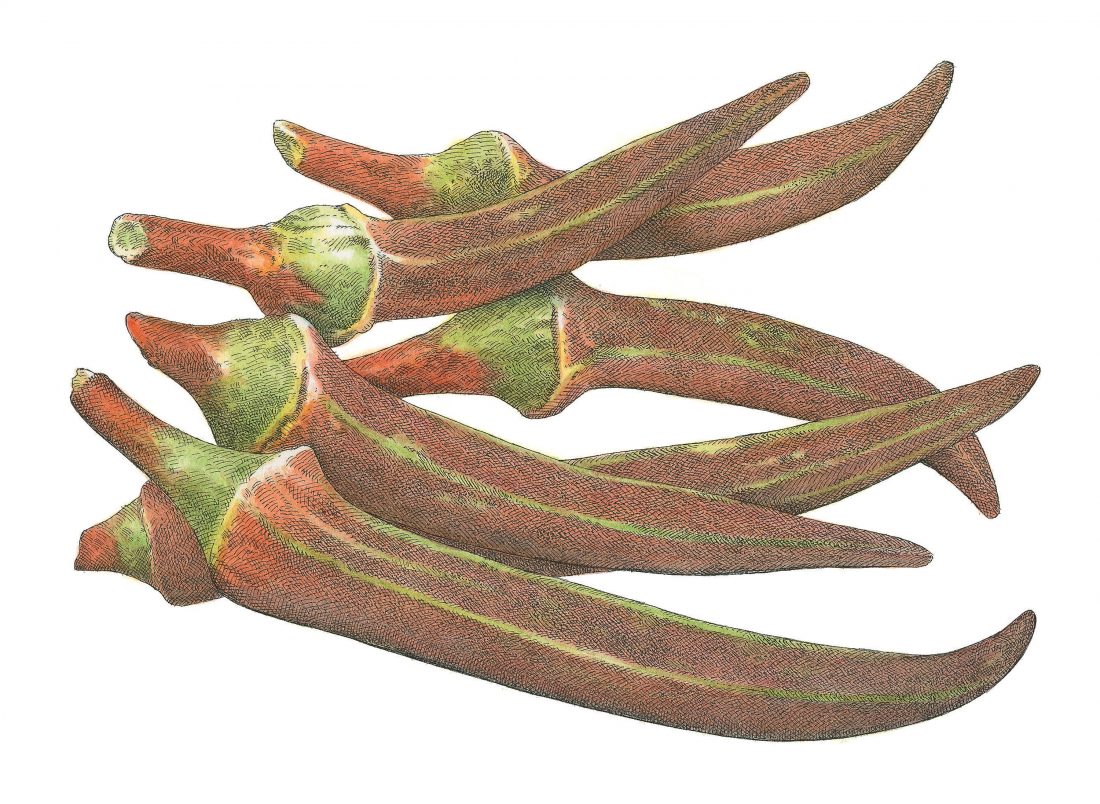Ask a Southern chef about okra, and you can expect a nostalgic answer. For Steven Greene of Herons restaurant at the Umstead Hotel and Spa in Cary, North Carolina, it evokes memories of youthful visits to his grandmother’s house in Abbeville, South Carolina. She would sear the vegetable in a hot cast-iron skillet with butter, pickle it, and, of course, fry it in a great batter. “I was hooked from then on,” he says. Today, okra is a staple on Greene’s menu, but he’ll often swap standard green okra for the less conventional Red Burgundy variety. Though it’s certainly pretty to look at—deep magenta pods that transition to green when exposed to heat—its allure is more than skin deep. “Taste-wise, Red Burgundy is very similar to other okra varieties, but I find it to be a little more tender and less slimy,” Greene says. Introduced in 1983 by scientists at Clemson University after eight years of careful tweaking, the crimson beauties have become eye-catching regulars at more and more mainstream grocery stores and farmers’ markets around the South come August and September. Make sure the pods don’t have any brown spots and, if the farmer okays it, snap one in half (it should break easily) to make sure it’s not overripe. They’ll keep only a few days max in the refrigerator, so eat them quickly, or follow the chef’s quick-pickle recipe. Covering them in salt, then rinsing pre-pickling will help eliminate the slime factor. But Chef Greene’s favorite preparation is to simply fry them in a crunchy batter, “just like Grandma used to do.”
Red Burgundy Okra Three Ways: Pickle it, Stew it, or Fry it
 Pickle It
Pickle It
“My favorite way to enjoy these pickled pods is on a pork-belly sandwich with some heirloom tomatoes and romaine lettuce.”
In a stainless-steel bowl, combine 1 lb. whole okra with 2½ tbsp. kosher salt. Let sit for at least an hour. In a heavy-bottomed pot, combine 16 oz. water, 24 oz. white vinegar, 12 white pearl onions (sliced lengthwise), 3 tbsp. mild pickling spice, 2 tbsp. sorghum syrup, and 2½ tbsp. kosher salt. Bring to a simmer. The brine is ready once salt has dissolved. Rinse okra to remove salt and slime, then transfer to a heatproof container and pour hot brine over top. Cool to room temperature before storing in the refrigerator for up to 3 weeks.
 Stew It
Stew It
“This simple stew highlights the fresh flavors of okra and tomatoes, two summer staples. It pairs best with seafood.”
In a medium saucepan, render 2 oz. bacon over medium heat. Add 3 sliced garlic cloves and 1 sliced shallot, and sauté. Stir in 1 tbsp. tomato paste and cook until it turns light brown, about 2 minutes. Reduce heat to medium-low and deglaze pan with 1 cup white wine. Stir in 4 tomatoes (cut into eighths), 1 tsp. minced thyme, 1 tsp. minced rosemary, and 1 lb. okra (sliced into 1-inch chunks). Stew until the tomatoes have reduced and stew has thickened, about 15 to 20 minutes.

Fry It
“The vegetable’s unique texture against the crunch of the tempura gives this dish wonderful balance.”
Fill a 9-inch cast-iron pot about three-quarters full of canola oil and heat to 360°F. Place ½ cup cake flour on a small plate. To make the tempura batter, mix 2 egg yolks gently with 2 cups ice water in a small bowl; then stir in another 2 cups cake flour using a chopstick (to avoid overworking the batter), allowing the mixture to remain a little lumpy. Mix in ¼ cup toasted benne seeds (or sesame seeds). Dredge whole okra pods in cake flour; then dip in tempura batter to coat. Add ½ cup sesame oil to the hot canola oil, to bring the temperature down to 350°F. Fry okra until golden brown. Salt to taste.








